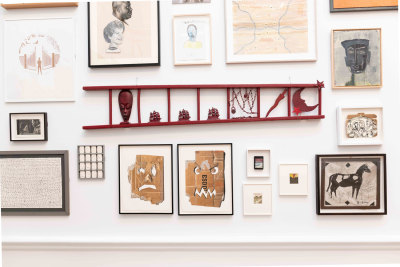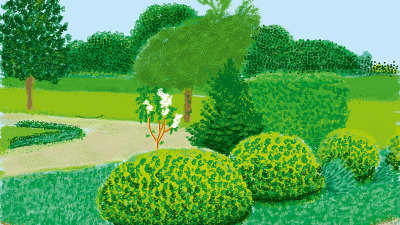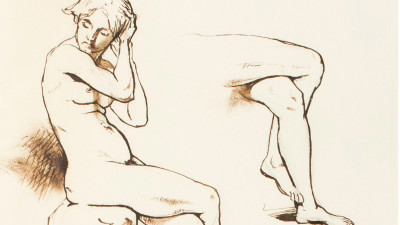Five graphic design ideas from the Russian Revolution
Five graphic design ideas from the Russian Revolution
By Steven Heller
Published 17 March 2017
Soviet designers gave us dynamic geometry, bold typography and minimalist colour that feels right at home in 2017. Designer and author Steve Heller shares five key ideas you need to know.
-
You’ll see it in the sans serif sign outside a hipster coffee shop, or in the monochrome patterned print of an expensive wallpaper. It looks curiously fresh. But lying behind much of what feels like breezy, urban, 21st century design is, in fact, the impact of a momentous period in history – that of a turbulent revolution.
Ending centuries of repressive Tsarist rule and replacing it, eventually, with the first Communist state, the 1917 Russian Revolution transformed politics, economics and, of course, culture – as can be seen in the RA’s current exhibition, Revolution: Russian Art 1917–1932. Debate set in as ideas of a new “people’s” art started to take shape. Modern design had begun to emerge throughout Europe and the United States, stimulating new creative energies and novel ways of making art, and in the Soviet Union, a period of profound creativity came with those early years of revolution.
Progressive young artists began to propagandise revolutionary virtues in mass art forms like books, magazines, textiles and posters. Agitational art and design movements, with names like Constructivists and Productivists, came up with alternative design languages and methods that changed accepted practices of graphic and product design, typography and architecture for generations to follow. A state-funded cultural education organisation set up in the wake of the Revolution, the Proletkult, rejected musty, traditional conventions and promoted a new, practical art that was responsive to the needs of people in the street. Until it was disbanded at Lenin’s behest, it provided a spring of forward-looking Communist ideals – chiefly that art must serve the needs of party and state for the good of all.
Today’s graphic designers, knowingly or not, owe a debt to the intrepid designers who were inspired, embattled and even persecuted by this momentous revolution. Many designers now employ these vintage mannerisms without any concept of the struggles that brought them or why they were suppressed for decades. Others understand that these -isms represent leaps forward and backward in modern culture. Visual language, like any other, is an amalgam of past and present, and the Russian Revolution’s contribution is endemic to the way a wide swath of typography, imagery and composition is made – a way that would not have existed without the crucible of revolution.
-
-

Minimalist colour
The Modern colour palette was minimal, primary and bold. Red was the primary colour – the colour of the proletariat, associated with working class revolutionary forces since the French Revolution of 1789. When paired with black, it creates a startling visual combination (see El Lissitzky’s Red Wedge, below). In addition to that pairing, yellow, blue and green were also frequently used alone or in combination. Colour ink was at a premium, so the use of just one or two colours was common; full or four-colour reproduction was expensive, and other stocks of colour were limited.
-
-
-

Abstraction and geometry
Among the progressive art and design groups were the radically abstract Suprematists, founded in 1915 by Kazimir Malevich. They introduced a formalist combination of pure geometry – the reduction of content to symbolic shapes and forms, along with a limited palette (see below). That unprecedented combination was the foundation upon which Constructivism – aiming to make art that reflected a modern, industrial society – and other European modernisms evolved. Anti-antiquarian works that proffered graphic revolution were the paradigms for waves of similar aesthetics in Germany, Holland, England, Eastern Europe and elsewhere. Many of these were, in turn, embraced by commercial designers and promoted by printing and typography journals in the capitalist world as codes for machine-age modernity.
-
-
-

"Agitprop"
All kinds of artistic viewpoints, from Cubism to Realism, became accepted expressive tools in the years that followed. But it was the unprecedented symbolic abstraction of Malevich and his contemporaries that became the recognised “revolutionary” art genre and the foundation of “agitation art”, or agitprop. In 1919, the Society of Young Artists was set up to produce posters and banners for social elevation and illumination, and a year later the Institute of Artistic Culture was founded in Moscow to train artists to produce design for proletarian use.
Applied avant garde artists like Alexander Rodchenko, Solomon Telingater, Valentina Kulagina, Sofia Dymshits-Tolstaya and especially El Lissitzky applied the shocking, geometric experiments of Kazimir Malevich to propaganda and advertising. This poster by El Lissitzky – its text translating as Beat the Whites with the Red Wedge – symbolises the Bolshevik forces conquering the Tsar’s White Russians.
These developments gave us much of what, today, is considered stereotypical Soviet-era art – the examples that heroically appear in all histories of 20th-century graphic design. But that geometric art wasn’t intended to be the only true Soviet form. It certainly was not Lenin’s first choice. Socialist Realism would come later.
-
-
Constructivist typography
Soviet graphic designers saw their work as a challenge to the old typographic order, and before Socialist Realism came to dominate the visual landscape (see below), avant garde typography was a defining element of the new Soviet aesthetic. Modern Constructivist typography was a melding of disparate typefaces in varying sizes. Typefaces were readable, but they were not composed on a page in the tradition manner of one or two typefaces in logical columns; instead there were multiple sizes and shapes within the same word or sentence.
Fonts were scrounged from wherever they could be found and the masters of the form, El Lissitzky, Solomon Talingater, Alexander Rodchenko and Gustav Klucis among them, combined serif and sans serif poster typefaces – with the type made in both metal and wood – to build veritable letterform word monuments.
This approach defined a short-lived Soviet style, but were eventually squeezed out in favour of Socialist Realism once Stalin came to power. Constructivist typography did, however, survive the Stalinist purge outside of the USSR, where it had a lasting impact on designers. In the 1920s, it fell under the umbrella of “The New Typography,” noted for its asymmetry, sans serif and slab serif geometry and lack of ornamentation. During the 1920s and 30s, this mode of communication was conveyed through professional trades and independent avant garde magazines, exhibitions and visiting professorships throughout the world, becoming the visual language and style of early design Modernism.
-
-

Heroic realism
The Soviet Union’s party ideologues quickly came to find the modern visual language suspect; abstract approaches were mysterious, blighted by hidden meanings that encouraged interpretation. These avant garde methods returned in the later 20th century, but not before they were superseded and pushed out of the public sphere by Socialist Realism in the late 1920s. A more conservative approach was the hallmark of the most influential visual and graphic arts group in the Soviet Union, the Association of Artists of Revolutionary Russia, formed in 1922. The Association called their evangelical revolutionary style “heroic realism.” The state’s preference for clear, unambiguous messages led to overly idealised representational art that replaced abstract ambiguity with unmistakable reflections of the revolution. Under Stalin, there was no longer place for play or experimentation and so, paradoxically, a neutered version of Constructivism was used a capitalist advertising tool to suggest modernity.
-
-
Steven Heller is co-chair of MFA Design at New York’s School of Visual Arts, and has written or edited over 170 books on graphic design and political propaganda, including Iron Fists: Branding the 20th Century Totalitarian State.
Revolution: Russian Art 1917–1932, Main Galleries, Royal Academy of Arts, 11 February – 17 April 2017.
-
-

A revolution-inspired RA profile picture
#profilerevolution
Taking inspiration from the pioneers of graphic design exhibited in our current blockbuster Revolution: Russian Art 1917-1932, we asked our social media followers to design a new profile picture for the Royal Academy.
The winner was Luca Bowles for this striking red-and-white logo. Chosen by exhibition curator Ann Dumas and curatorial assistant Rebecca Bray, they praised the “bold design drawing on several aspects of Russian graphic design, very skilfully done.”
You can see our new profile picture in action on our Twitter and Instagram pages. Search the hashtag #profilerevolution on either channel to see the other inspiring entries.
-








